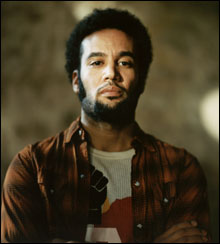 “Living these days is makin’ me nervous,” Ben Harper sings at the start of the title tune of his new Both Sides of the Gun (Virgin). And the guitarist and singer-songwriter isn’t alone.
“Living these days is makin’ me nervous,” Ben Harper sings at the start of the title tune of his new Both Sides of the Gun (Virgin). And the guitarist and singer-songwriter isn’t alone.
Like many artists who haven’t previously been associated with protest music, including Tom Waits, Green Day, and bluesman Robert Cray, Harper has been polarized by the world’s jittery state. The swirl of poverty, racism, nationalism, imperialism — you name the divisive ’ism and chances are we’re living it — resonate through many of his new songs. And in “Both Sides of the Gun,” he draws a bead on the sense of disenfranchisement many rational Americans are suffering. “I feel like I’m crowded/I can’t get out,” he sings in the second verse. “World keeps on filling me up with doubt/When you’re trapped you’ve got no voice/When you want you got no choice/Other than to take you some/It’s tension/Too much to mention/When you’ve livin’ on both sides of the gun.”

“Social change and social justice have never been handed down to any generation, culture, or era,” he suggests when I reach him by phone on a tour stop in Florida. “It always must be demanded and fought for, so I don’t expect that to be any different now. World events, Katrina included, all seem to be pushing us more toward demanding justice. But my fear is, if Americans aren’t taking to the streets for this administration and its actions, what are they going to be in the streets for?”
We talk about the loaded imagery of his album’s title. The pilings of the United States were driven into the ground with gunpowder, so guns have a potent and ongoing role in our history and culture, right up to the current war in Iraq and the growing street violence in Boston and other cities. “If we don’t want people shooting each other, or at helicopters, we need to put some money into managing handguns. Or if we don’t want people shooting at helicopters from rooftops, maybe they should pick people up when they’re starving and their lives are threatened instead of flying past them.”
That’s a reference to New Orleans. Both Sides of the Gun’s “Black Rain” is sparked by the devastation of the Crescent City and the federal negligence that compounded it. By the time the tune ends, Harper is predicting nothing short of revolution, or at least the overthrow of the current political power structure that’s betrayed the American trust. “Something of the magnitude of Katrina really pushes things toward civil unrest for a lot of reasons — civil rights, economic empowerment. I think there’s a lot of rage in the wake of Katrina that’s eventually going to be channeled somewhere, which is only natural in the face of that kind of blindness to the values of human lives.”
His music has always dealt with life’s yin and yang, but the tug between the two has never been stronger than in these 18 new numbers. So much so that when he was sequencing the album, Harper realized that he had to divide the material into two discs, the first filled with personal-sounding songs about love and desire and the spiritual realm, the second an often blistering collection of protest songs. Each disc clocks in at about a half-hour apiece — “which makes the listening experience like hearing two sides of an album, like in the days of vinyl, more than listening to a two-CD set. A lot of classic albums had different moods for each side [Neil Young’s Rust Never Sleeps, on Reprise, is one enduring example], and these songs just divided themselves into different camps naturally.” Indeed, Both Sides of the Gun offers passages of pure beauty — like “Sweet Nothing Serenade,” an uplifting showcase for his inventive approach to the esoteric Weissenborn lap slide guitar — alongside the protest numbers and declarations of truth and purpose like the stomping, questioning “Serve Your Soul,” which uses a stew of electric Telecaster, acoustic six-string, and lap steel to conjure the magic of Led Zeppelin and Jimi Hendrix.
Raised around his grandparents’ Southern California folk-music store and performance center, surrounded by the likes of bluesman Brownie McGhee and slide-guitar expert David Lindley (who makes a cameo on tambura, a bowed Turkish instrument, on “Better Way”), Harper has always been a musical eclectic. His style draws from practically every roots school, from folk to blues to rock to reggae to soul to spirituals to jazz. Being a singer-songwriter whose primary instrument is lap-slide guitar makes him even harder to categorize.